Overview
In today's healthcare landscape, the emotional challenges faced by providers are significant. Administrative burdens can weigh heavily, impacting the quality of patient care. Remote radiology transcription jobs are increasingly in demand because they play a crucial role in alleviating these pressures. By converting audio recordings of radiology reports into accurate written documents, these professionals enhance patient care and streamline administrative processes.
These positions offer remarkable flexibility and competitive salaries, allowing professionals to contribute meaningfully to healthcare. Imagine being part of a solution that not only supports your career but also improves patient outcomes. The integration of specialized skills and technology in this field is vital for enhancing efficiency, which is something we all strive for in our demanding roles.
As you consider your next career move, think about how remote radiology transcription could fit into your life. Wouldn't it be fulfilling to work in a role that values your expertise while making a tangible difference in healthcare? Embrace the opportunity to grow in a supportive environment where your contributions matter.
Key benefits of remote radiology transcription jobs include:
- Flexibility to work from anywhere
- Competitive salaries that reflect your skills
- The chance to significantly impact patient care
By exploring this career path, you can find a role that aligns with your values and professional goals. Together, we can address the challenges in healthcare, ensuring that every patient receives the attention they deserve.
Introduction
In the ever-evolving landscape of healthcare, remote radiology transcription jobs have emerged as a vital component, transforming the way patient information is documented and managed. These roles not only facilitate the accurate conversion of audio recordings into written reports but also allow radiologists to concentrate on what they do best: diagnosing and treating patients. As telehealth services gain traction, the demand for skilled transcriptionists is rising, offering individuals a unique opportunity for flexible and rewarding careers.
This article delves into the multifaceted world of remote radiology transcription, exploring its significance and the benefits of remote work. It also outlines essential qualifications and the tools needed to excel in this growing field. With insights into current job opportunities and future trends, it serves as a comprehensive guide for those looking to navigate this promising career path.
Are you ready to explore how you can contribute to improving patient care while enjoying the flexibility of remote work?
Understanding Remote Radiology Transcription Jobs
The role of is crucial in transforming audio recordings of radiology reports, dictated by radiologists, into accurate written documents. This function is vital for maintaining precise documentation of patient imaging results, which is essential for effective patient care. As medical services increasingly embrace telehealth offerings, the demand for remote radiology transcription jobs has surged, making this a promising career path for individuals seeking flexible work arrangements.
Transcriptionists operate from home, allowing them to significantly contribute to the medical system by alleviating the administrative burden on radiologists. This enables radiologists to concentrate on interpreting images and making critical clinical decisions rather than getting bogged down by paperwork. By streamlining processes such as documentation, appointment scheduling, and medical record management through AI solutions, medical service providers can reclaim valuable time to focus on delivering high-quality care to their patients.
CosmaNeura provides innovative AI solutions specifically tailored for the faith-centered medical sector, improving the efficiency of medical documentation and enabling professionals to dedicate more time to patient care. In fact, the incorporation of voice-activated and virtual health assistants is anticipated to further enhance the efficiency of medical record keeping by 2025, automating documentation processes and improving overall workflow and patient results.
The significance of precise documentation in medical practice cannot be overstated. It not only ensures that patient records are reliable but also supports better clinical outcomes. Based on recent data, the median yearly income for all employees in this sector was $48,060 as of May 2023, indicating the increasing acknowledgment of the importance of transcribers in the medical ecosystem.
U.S. News has evaluated careers based on wage potential, employment opportunities, future prospects, comfort, and work-life balance, indicating that transcription jobs are increasingly viewed as viable and rewarding career options. Expert opinions highlight that while technology plays a significant role in transcription, human expertise remains indispensable for achieving the highest levels of accuracy, particularly when dealing with complex medical information or challenging audio quality. This highlights the continuous demand for skilled typists who can manage the intricacies of medical records.
Furthermore, CosmaNeura distinguishes itself as the sole company offering AI solutions customized for the faith-centered medical sector, appealing to providers looking for inventive and ethical options in their work.
In conclusion, remote radiology transcription jobs are essential to the medical landscape, ensuring that crucial patient information is precisely documented and easily accessible. Their efforts not only improve the effectiveness of radiology departments but also directly influence patient care, making this profession a fulfilling and vital part of contemporary medical services.
Benefits of Remote Work in Radiology Transcription
Working remotely as a radiology transcriptionist offers a multitude of advantages that significantly enhance both professional and personal life, especially in the context of remote radiology transcription jobs. These benefits can truly make a difference in your daily experience.
- Flexibility: Imagine the freedom to set your own schedule. Remote transcriptionists enjoy this flexibility, fostering a healthier work-life balance. This is particularly beneficial in , where demands can be unpredictable, allowing you to adapt to your personal needs.
- Cost Savings: Eliminating commuting expenses and the time associated with travel can lead to substantial financial savings. In today's economy, where every dollar counts, this aspect becomes even more relevant for professionals in the field.
- Increased Job Satisfaction: Many transcriptionists report heightened job satisfaction due to the autonomy of working from home. Recent findings indicate that telecommuters often experience emotional exhaustion and occupational injuries less frequently than their in-office counterparts. Yet, it's important to acknowledge that nearly 53% of telecommuting workers feel it's harder to connect with their coworkers, which can impact job satisfaction. The ability to manage your own time contributes to a more fulfilling work experience.
Remote radiology transcription jobs also provide access to a broader job market by breaking down geographical barriers. This allows transcriptionists to apply for roles across the country, increasing opportunities and enabling you to find positions that align closely with your skills and values.
- Enhanced Psychological Support: The transition to virtual work during the pandemic highlighted the importance of mental health in the workplace. Teleworking has been shown to decrease physical presence in the workplace, reduce working hours, and offer enhanced psychological support for medical staff. A case study titled 'Advantages of Teleworking in the Medical Field' illustrates that this shift has been instrumental in mitigating the adverse effects of COVID-19, showcasing the long-term benefits of working from a distance in the medical sector.
- Expert Insights on Job Satisfaction: Specialists agree that the flexibility inherent in distance roles significantly affects job satisfaction. Tailoring work hours to personal needs not only enhances productivity but also contributes to overall well-being.
In summary, the shift to remote radiology transcription jobs not only supports individual needs but also aligns with broader trends in healthcare, promoting a healthier, more satisfied workforce. Consider how these advantages could positively impact your life and explore the possibilities that await you.
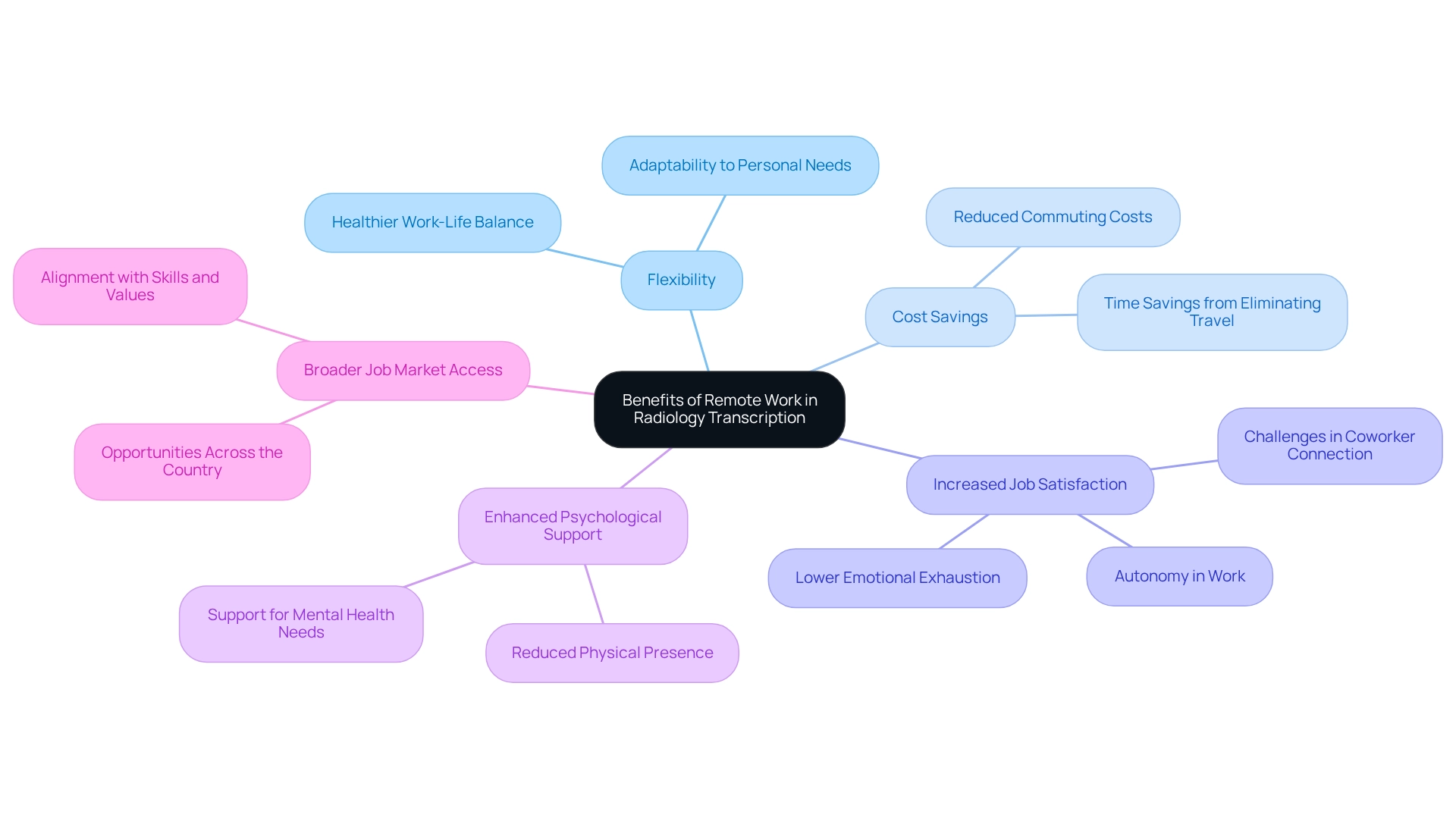
Key Qualifications for Remote Radiology Transcriptionists
To qualify for remote radiology typing positions, candidates often face several key qualifications that can feel overwhelming.
- Educational Background: A high school diploma is essential, while an associate degree or certification in medical documentation is often preferred. These educational credentials provide foundational knowledge crucial for success in the field.
- Typing Skills: Proficiency in typing is critical, with a minimum requirement of 60 words per minute. This speed ensures that individuals can effectively transform audio recordings into written documents without sacrificing precision.
- Knowledge of Medical Terminology: Familiarity with medical terminology, particularly in radiology, is necessary for accurate recording. Understanding terms related to imaging techniques and diagnostic procedures enhances the quality of work produced in , where attention to detail is vital for catching errors and ensuring accuracy in documentation. Medical typists must meticulously review their work to maintain high standards of patient care and legal compliance.
- Average Wage Insights: According to recent statistics, the wage for medical typists varies significantly, with the 90th percentile earning approximately $46,800 annually in the Phoenix-Mesa-Scottsdale area. This highlights the potential for financial advancement in this field, especially for those who concentrate on specialties such as radiology.
- Training Programs: Numerous training programs exist for aspiring medical typists, including online courses and certification programs that focus on medical terminology, typing techniques, and the use of typing software. These programs equip candidates with the essential skills to thrive in remote roles.
- Expert Advice: Industry leaders stress that focusing on a specific field of medical documentation, such as radiology, can greatly enhance earning potential and job prospects. As Ashley Today highlights, this specialization not only improves career progression but also contributes to a more rewarding professional experience.
By fulfilling these requirements, candidates can position themselves effectively for remote radiology transcription jobs that offer flexibility and competitive compensation. Furthermore, platforms like CosmaNeura are transforming the healthcare landscape by automating administrative tasks, enabling those who handle documentation to concentrate on their expertise while adhering to ethical standards in patient care. This journey may seem challenging, but with the right preparation and support, you can find a fulfilling career in this vital field.
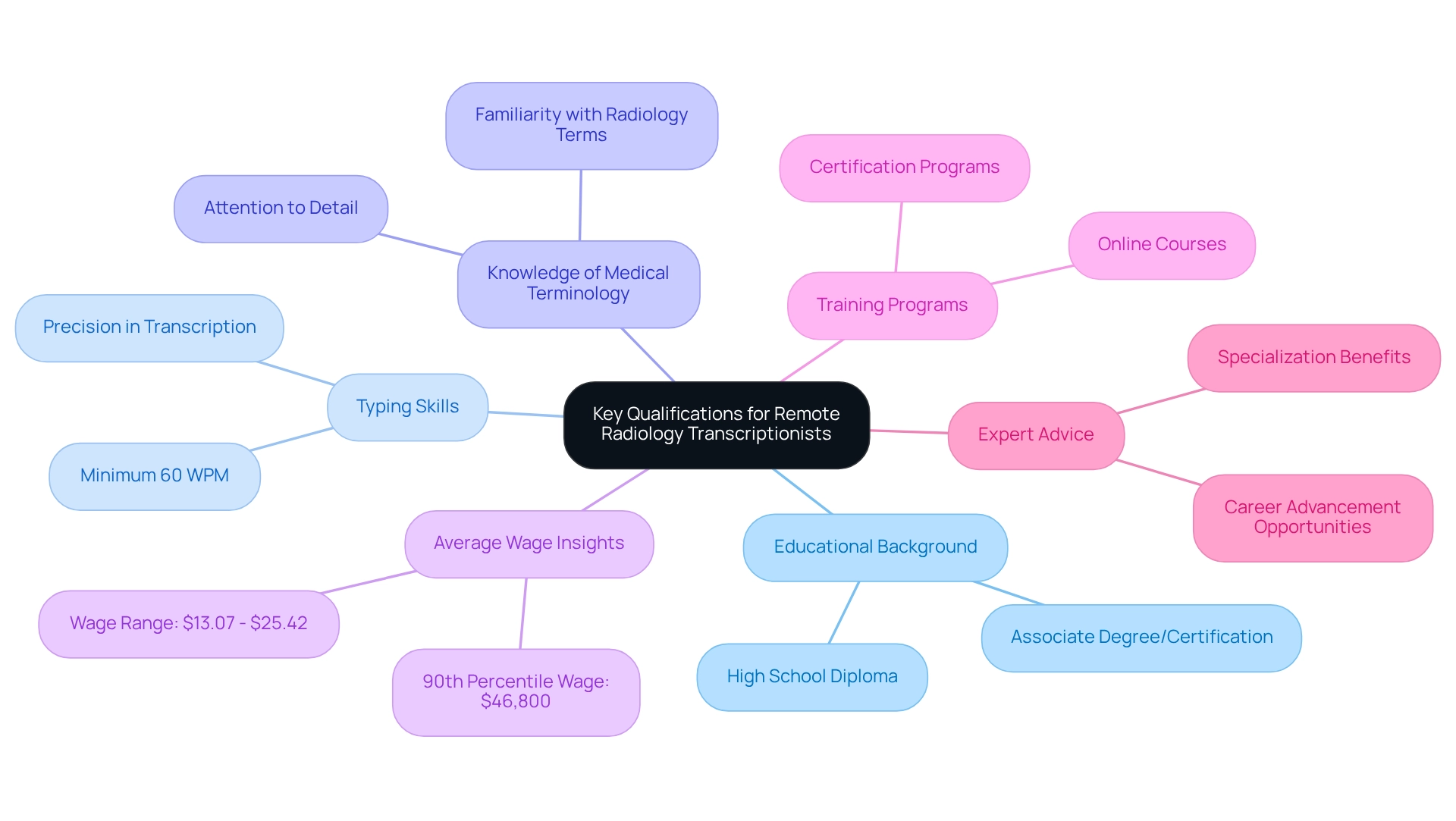
Top 10 Remote Radiology Transcription Jobs Available Now
Here are ten distant radiology transcription jobs currently available:
- Radiology Transcriptionist at ABC Health Services - $20/hr, flexible hours.
- Remote Medical Scribe at XYZ Radiology - $25/hr, full-time.
- Transcriptionist for Telehealth Services at HealthCorp - $22/hr, part-time.
- Freelance Radiology Transcriptionist at MedTranscribe - $18-$30/hr based on experience.
- Full-Time Remote Transcriptionist at Radiology Associates - $24/hr, benefits included.
- Part-Time Medical Transcriptionist at TeleMed - $20/hr, work from anywhere.
- Contract Radiology Transcriptionist at QuickTranscribe - $19/hr, project-based.
- Remote Medical Transcriptionist at CareHealth - $21/hr, flexible scheduling.
- Radiology Report Transcriptionist at HealthNet - $23/hr, full-time.
- Freelance Medical Transcriptionist at TranscribeMe - $15-$25/hr, depending on workload.
In 2025, the demand for remains strong, with numerous companies actively recruiting for positions that allow working from home. Have you considered how this flexibility could impact your work-life balance? The typical salary for a transcriptionist working from home in the United States is around $49,746 annually, with a spectrum from $40,436 to $61,511. This indicates the varied opportunities present in this field, which can be a significant factor for job seekers.
Significantly, Georgia ranks 62nd out of 50 states for remote medical salaries. This highlights that while there are opportunities, pay may differ greatly by area. It’s essential for job seekers to consider this when exploring options.
As the medical landscape evolves, remote radiology transcription jobs not only offer flexibility but also play a vital role in improving patient care. Have you thought about how your contributions could enhance patient experiences? This aligns with the mission of platforms like CosmaNeura, which seeks to transform medical service delivery by automating administrative tasks and enhancing job satisfaction among providers. By embodying the compassionate spirit of Catholic healthcare, CosmaNeura reinforces the ethical practices that are essential in these roles.
How to Apply for Remote Radiology Transcription Jobs
To successfully apply for remote radiology typing jobs, consider the following steps:
- Update Your Resume: Ensure your resume is current and emphasizes relevant skills, experience, and certifications specific to typing and healthcare.
- Craft a Tailored Cover Letter: Write a personalized cover letter that addresses the specific job requirements. Highlight your passion for medical services and how your values align with the mission of the organization, particularly if you resonate with the like CostaNera, a leader in the market.
- Prepare for Interviews: Anticipate questions concerning your experience with typing and familiarity with medical terminology. Be prepared to show your comprehension of the role and its effect on patient care, particularly considering how documentation technologies can enhance turnaround time (TAT) by 2 to 3 times, improving efficiency in healthcare delivery.
- Utilize Job Boards: Actively search for openings on platforms such as Indeed, ZipRecruiter, and LinkedIn, which frequently list remote radiology transcription jobs.
- Network: Connect with experts in the industry via LinkedIn or dedicated forums. Networking can uncover unadvertised job opportunities and provide insights into the hiring process.
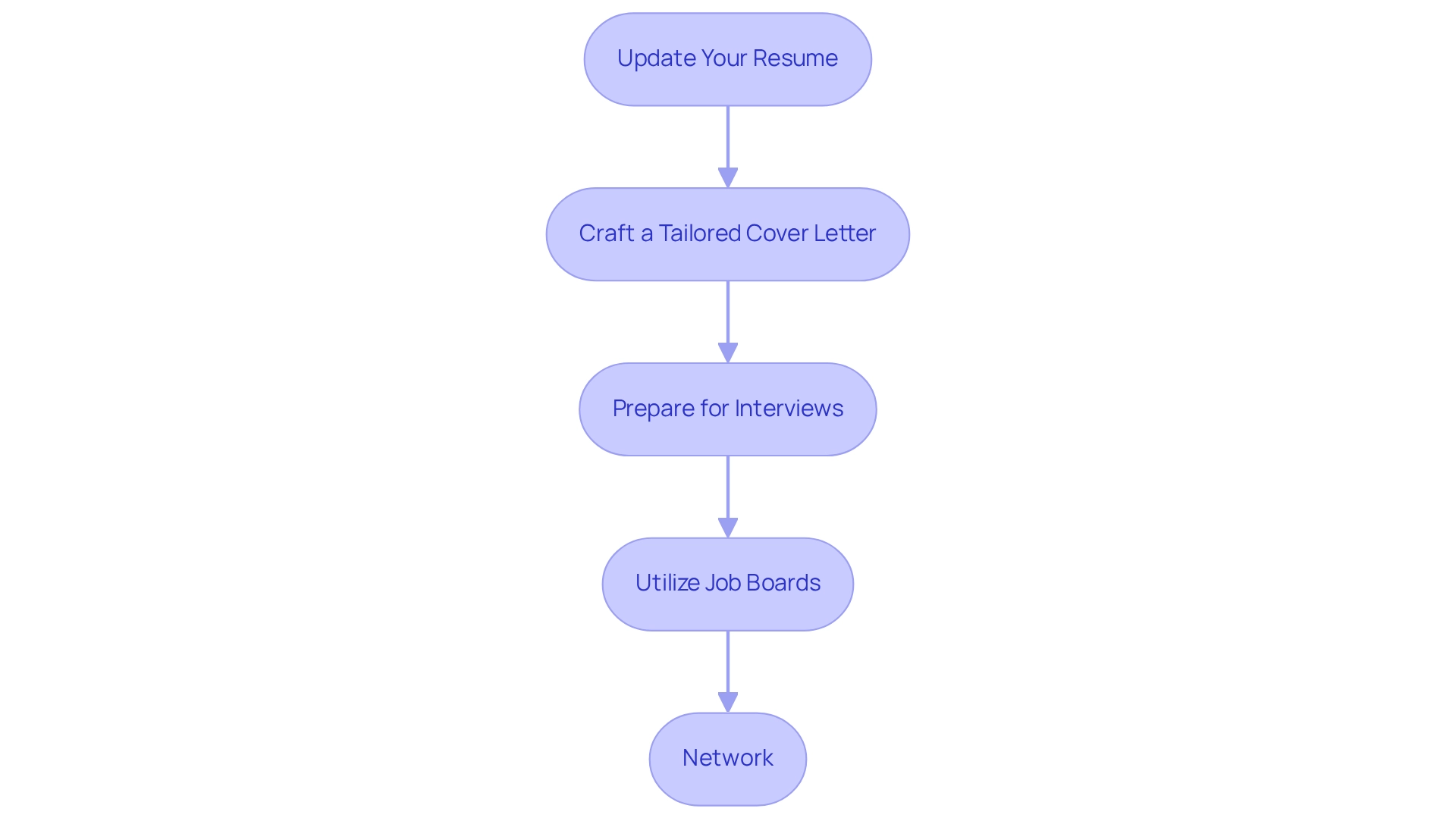
Networking and Professional Development in Radiology Transcription
are vital for advancing in remote radiology transcription jobs. Many healthcare providers face emotional challenges as they navigate their careers. By addressing these concerns, we can explore effective strategies to enhance your career:
- Join Professional Organizations: Becoming a member of associations such as the Association for Healthcare Documentation Integrity (AHDI) can provide valuable resources and networking opportunities that are crucial for career growth. Consider how CostaNera, the sole company focusing on the faith-oriented medical sector with AI solutions, illustrates the impact specialized organizations can have on improving patient care.
- Attend Workshops and Webinars: Engaging in training sessions not only sharpens your skills but also keeps you informed about the latest industry trends and best practices.
- Engage on Social Media: Utilize platforms like LinkedIn to follow industry leaders and participate in discussions. This can help you gain insights and connect with fellow professionals.
- Seek Mentorship: Establishing a relationship with a mentor in the field can offer guidance and support, helping you navigate the complexities of your career.
Statistics indicate that networking enables medical professionals to adopt a multidisciplinary approach to patient care, enhancing overall effectiveness. However, disparities in access to networking opportunities, particularly in academic medicine, underscore the need for intentional actions to promote inclusivity. As highlighted in the case study titled "Networking in Academic Medicine: Addressing Inequities," significant barriers exist for underrepresented groups in accessing these opportunities.
Sherine Salib, a Professor of Internal Medicine, emphasizes that "Inclusivity is key" in addressing these disparities. Moreover, there is a growing call for institutions to recognize and address the 'network gap' for those with reduced access to networking and sponsorship opportunities. By actively pursuing these networking strategies, radiology specialists can significantly enhance their professional development and career prospects, including securing remote radiology transcription jobs. How will you take the next step in your professional journey?
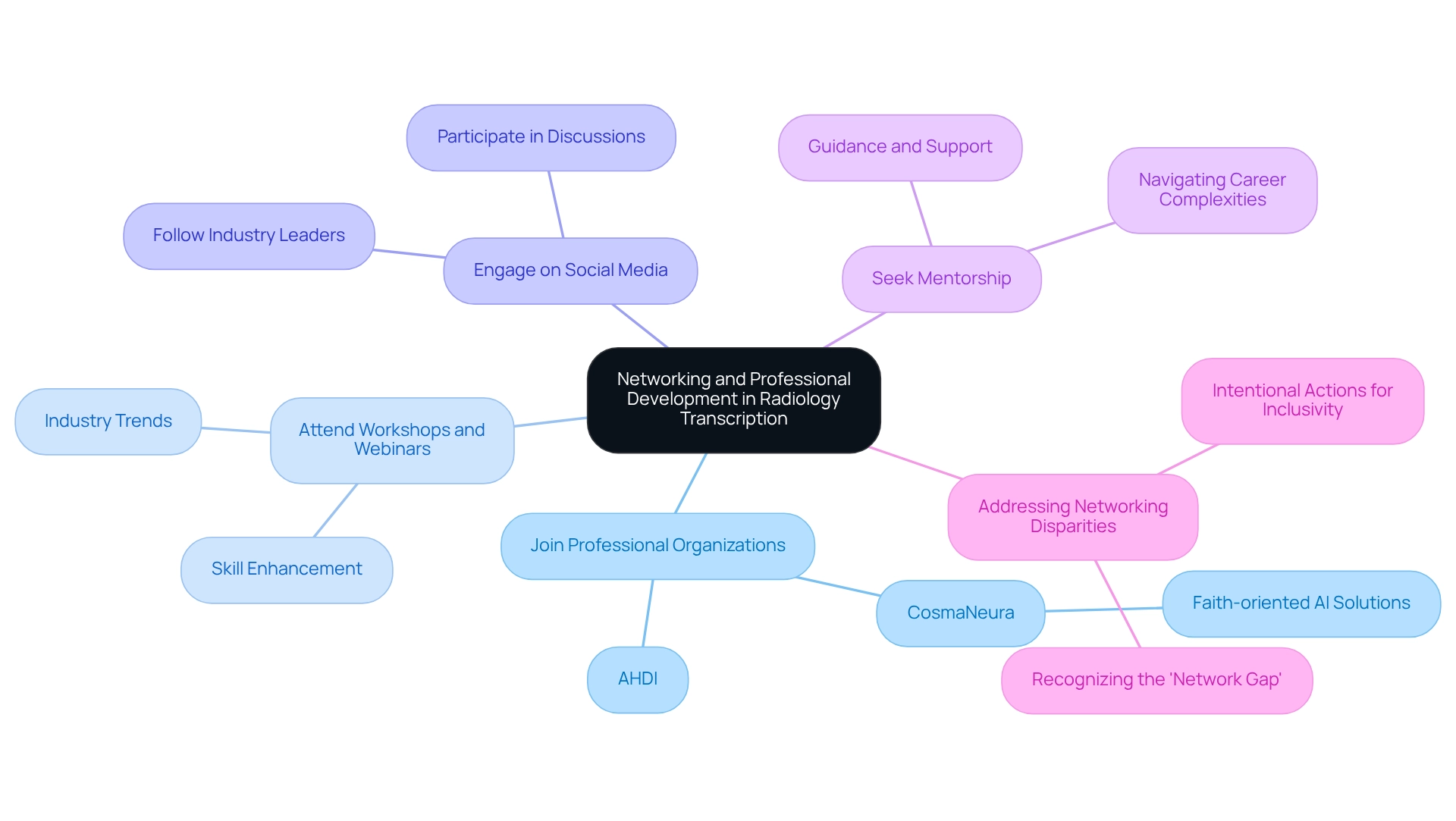
Challenges of Remote Radiology Transcription Work
While remote radiology transcription offers numerous advantages, it also presents several challenges that professionals must navigate, particularly in the context of transforming healthcare delivery through AI-driven solutions.
- Isolation: The solitude of working from home can lead to feelings of loneliness, impacting mental well-being and job satisfaction. Have you considered establishing regular virtual check-ins with colleagues or participating in online forums? These strategies can foster a sense of community and support, which is crucial in a field where collaboration enhances care delivery.
- Distractions: Home environments often come with various distractions, from household chores to family interruptions. Creating a dedicated workspace that minimizes these distractions is essential for maintaining focus and productivity, allowing transcriptionists to deliver high-quality work that aligns with patient-centric care.
- Technology Issues: The dependence on technology for recording tasks means that technical difficulties can significantly disrupt workflow. It's crucial to have contingency plans in place, such as alternative devices or access to IT support, to mitigate these disruptions. AI tools can also streamline processes, reducing the impact of such issues.
- Maintaining Accuracy: The pressure to produce high-quality, accurate transcriptions can be stressful. Cultivating robust proofreading habits and employing AI tools for initial drafts can assist professionals in managing this stress while ensuring precision in their work, ultimately enhancing patient outcomes.
- Challenges Faced by Remote Workers: Statistics indicate that remote workers often report feelings of isolation and distractions as significant barriers to their productivity. Addressing these issues proactively can lead to improved job satisfaction and performance, especially as the demand for remote radiology transcription jobs increases due to an aging population and the prevalence of chronic diseases.
- Expert Insights: Experts emphasize the importance of creating a structured daily routine to combat isolation and distractions. This includes setting specific work hours, taking regular breaks, and engaging in professional development activities to stay connected with the field, which is vital for maintaining high standards of care.
- Real-World Examples: Many transcriptionists have successfully implemented strategies to overcome distractions, such as using noise-canceling headphones or establishing 'do not disturb' signals with family members during work hours. As James Padley, Chief Operating Officer, noted, "Recruiting was becoming an issue because people didn't want to commute out to where we were... it's now enabled us to recruit much wider, because we can offer remote work for people."
- Comparative Perspective: Companies like TranscribeTube are emerging as leaders in the market due to that enhance speed and accuracy. This emphasizes the potential for AI to tackle some of the challenges encountered by transcribers, enhancing productivity and quality while aiding in the overall goal of improving medical service delivery.
By acknowledging and addressing these challenges, distance radiology transcriptionists can enhance their work experience and maintain high standards of accuracy and efficiency, all while contributing to the mission of improving the quality of care in healthcare, as exemplified by CosmaNeura's commitment to ethical practices.
Essential Tools for Remote Radiology Transcriptionists
To excel in remote radiology transcription jobs, it is essential to equip yourself with the right tools that enhance productivity and efficiency, ultimately contributing to improved patient care. Consider the following essential tools:
- High-Quality Headphones: Clear audio is paramount in typing work. Investing in high-quality headphones ensures that you can accurately capture every detail of the audio, minimizing errors and improving the overall quality of the written text.
- Foot Pedal: A foot pedal is an invaluable tool that allows for hands-free control of audio playback. This feature greatly enhances productivity, enabling typists to concentrate on typing without the necessity to continually alternate between keyboard and mouse.
- Transcribing Software: Using like Express Scribe or Dragon NaturallySpeaking can simplify the transcribing process. These programs frequently include features such as automated text expansion and voice recognition that improve precision and speed, making them vital for remote work.
- Reliable Computer: A fast and dependable computer with sufficient RAM is essential to manage conversion software and large audio files efficiently. This guarantees seamless functioning and minimizes inactivity, enabling typists to operate more effectively.
The incorporation of these resources can lead to significant time savings; research shows that AI typing tools can conserve nearly 80% of the time usually invested in typing tasks. Moreover, with 97% of mobile users employing AI voice assistants, the market for digital voice assistants is set for substantial growth, emphasizing the rising dependence on technology in transcription roles.
CosmaNeura illustrates how AI-driven services can revolutionize medical delivery, particularly in transcription. By automating administrative tasks such as appointment scheduling and medical record management, CosmaNeura enables providers to concentrate on patient care, thus increasing job satisfaction and enhancing the quality of work. This optimization of processes reduces the strain on healthcare providers, allowing them to provide high-quality care more effectively.
By utilizing these essential tools, off-site transcribers in remote radiology transcription jobs can improve their workflow, boost job satisfaction, and ultimately produce superior quality work in the field of radiology.
Future Trends in Remote Radiology Transcription
The future of remote radiology documentation is on the brink of significant transformation, shaped by several key trends that resonate deeply with healthcare providers' experiences:
- Increased Use of AI: Imagine a world where artificial intelligence revolutionizes documentation processes. AI technologies can automate routine tasks, allowing transcriptionists to focus their expertise on the more complex and nuanced aspects of their work. This shift not only boosts efficiency but also enhances the precision of records, ultimately leading to better patient outcomes. Analysts predict that AI-enabled point-of-care devices will empower non-experts to make initial evaluations and provide immediate assistance, promoting faster interventions and treatment choices.
- Telehealth Expansion: As telehealth services continue to grow, the demand for documentation services is rising. Healthcare providers increasingly rely on virtual consultations, which necessitates precise and prompt documentation. This trend is underscored by the projected growth of , expected to reach approximately US$ 1,971.4 million by 2026. This growth is driven by the increasing incidence of chronic diseases and heightened consumer awareness. Notably, the Emergency Nighthawk service type segment is anticipated to register the fastest CAGR over the forecast period.
- Focus on Data Security: With the rise of remote work, protecting patient data has become more critical than ever. The documentation sector is making strides in secure recording technologies to safeguard sensitive information. This commitment to data protection not only meets regulatory standards but also fosters trust between patients and healthcare providers.
- Impact of AI on Medical Documentation Roles: The infusion of AI into medical documentation is expected to reshape job roles significantly. While some routine tasks may be automated, the demand for skilled transcriptionists who can interpret complex medical language and context will remain strong. This duality presents both challenges and opportunities for experts in the field.
- Case Studies on AI Impact: The teleradiology services market exemplifies the potential of AI in documentation. Despite challenges such as high expenses and a lack of skilled professionals, the market is poised for significant expansion, highlighting the growing dependence on AI-driven solutions in the medical field. This growth aligns with CosmaNeura's mission to enhance patient care quality through innovative AI solutions designed for the faith-focused healthcare market.
As these trends unfold, the landscape of remote radiology transcription jobs will evolve, opening new opportunities for professionals ready to adapt to the changing field of healthcare documentation. Are you prepared to embrace these changes and enhance your impact on patient care?
Taking the Next Steps in Your Remote Radiology Transcription Career
To advance your career in , consider implementing the following strategies:
- Continue Learning: Staying abreast of industry trends is crucial. Have you thought about how participating in online courses and workshops focused on the latest typing technologies and medical terminology can empower your career? Continuous education not only sharpens your skills but also positions you as a knowledgeable candidate in a competitive job market. Cultivating robust typing and listening abilities, along with a firm grasp of industry terminology, is vital for becoming a successful transcriber.
- Build Your Network: Networking is essential in this field. How can connecting with fellow typists, healthcare professionals, and industry leaders through social media platforms and professional organizations enhance your career? This can lead to valuable insights about remote radiology transcription jobs and best practices, thereby opening doors to new opportunities.
- Apply for Jobs: Are you actively searching for remote radiology transcription jobs that align with your skills and interests? Utilize job boards, company websites, and your professional network to discover opportunities. Focusing on remote radiology transcription jobs can significantly enhance your earning potential, as medical professionals in specialized fields often command higher wages. For instance, the 90th percentile annual wage for medical typists is $52,880, highlighting the financial benefits of specialization.
- Seek Feedback: After interviews or job applications, consider proactively requesting feedback. How can understanding areas for improvement refine your approach and boost your chances of securing a position? This practice not only demonstrates your commitment to professional growth but also helps you adapt to the expectations of potential employers.
- Career Advancement Opportunities: As you gain experience, have you thought about specializing in specific medical fields such as cardiology or oncology? This can lead to higher wages and more advanced roles. Many typists transition into management roles or even establish their own typing enterprises, showcasing the varied career options available in this area. The industry employment trends indicate a stable demand for transcription-related services across various healthcare settings, reinforcing the potential for career growth.
- Importance of Continuous Learning: The healthcare landscape is ever-evolving, making continuous learning vital. Engaging in ongoing education, such as certification programs, can open doors to new opportunities and enhance your credibility as a transcriptionist. Specialized training can lead to roles that require advanced knowledge of medical terminology, further increasing your marketability in remote radiology transcription jobs. By following these steps, you can effectively navigate your career in this field, positioning yourself for success in a sector that continues to grow and evolve.
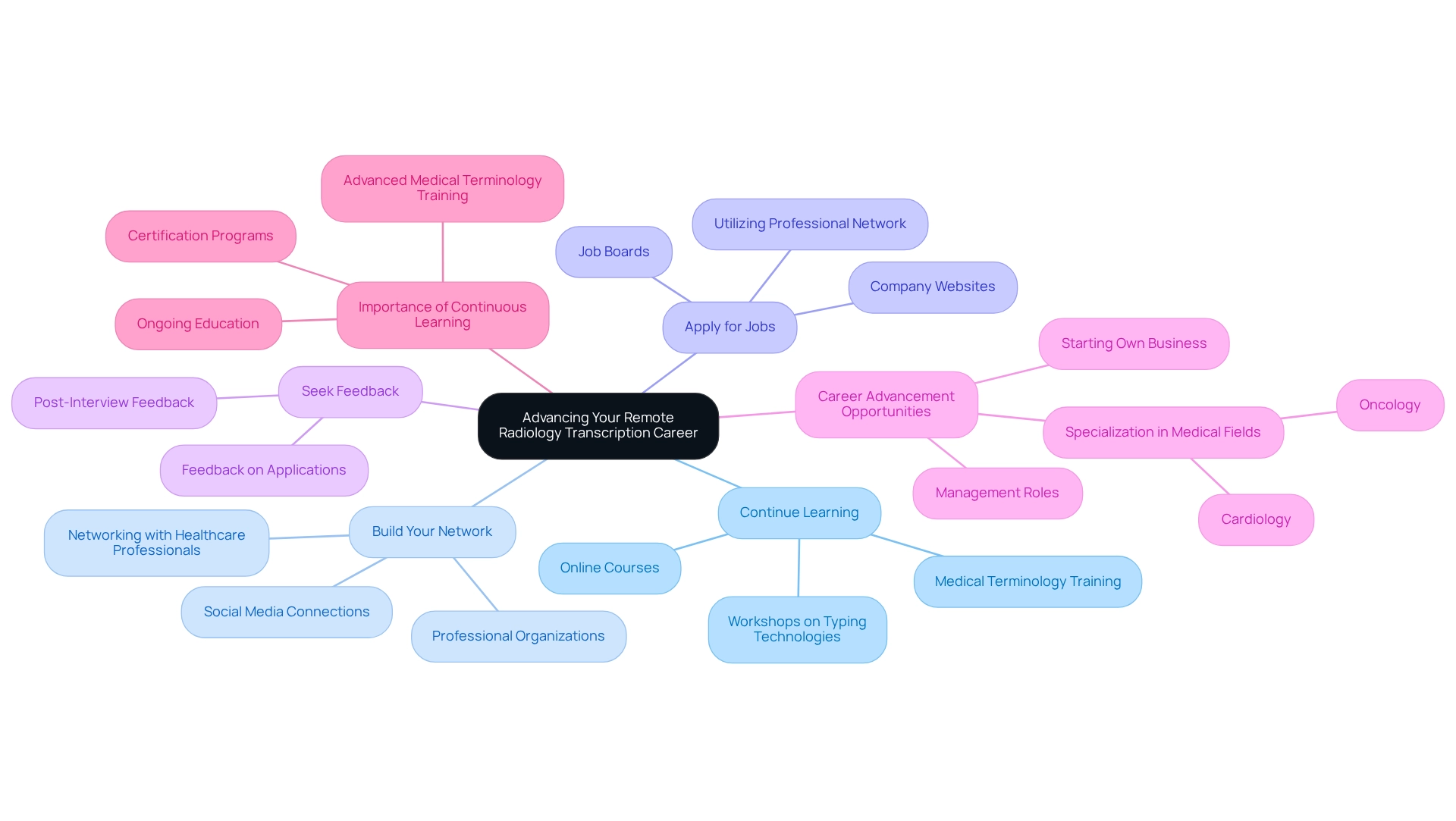
Conclusion
Remote radiology transcription jobs have become a vital part of modern healthcare, ensuring that essential patient information is accurately documented and easily accessible. As telehealth services grow, the need for skilled transcriptionists has only intensified. These professionals play a crucial role in easing the administrative load for radiologists, ultimately enhancing patient care. With the flexibility of remote work, they can achieve a healthier work-life balance while making significant contributions to the healthcare system.
As the healthcare landscape evolves, the importance of specialized skills, knowledge of medical terminology, and proficiency in transcription technologies is more critical than ever. By equipping themselves with the right tools and committing to ongoing education, transcriptionists can boost their productivity and maintain high accuracy standards in their work. The integration of AI and other technological advancements is set to further revolutionize the transcription process, creating new opportunities for professionals in this field.
In conclusion, the future of remote radiology transcription is promising, marked by an increase in job opportunities and a growing appreciation for the essential role transcriptionists play in patient care. As the industry navigates new challenges and trends, those entering or advancing in this profession are encouraged to embrace continuous learning and networking. By doing so, they can position themselves for fulfilling careers that not only align with their professional goals but also contribute to the overarching mission of enhancing healthcare delivery. Now is the perfect time to explore this rewarding career path, with substantial benefits for both individuals and the broader healthcare community.




